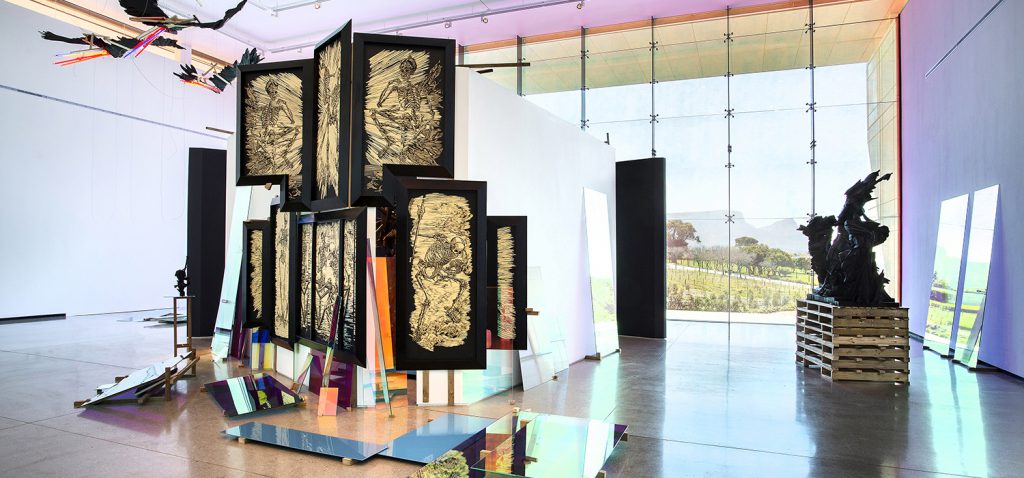BD Art
Public-Private Collections
As state funding for public art museums dwindles, privately-backed institutions are opening up to fill the void, playing an important cultural role by revitalising new audience engagement, reports Tymon Smith.
Although the South African art market has gone from strength to strength in the democratic era, this has not necessarily been reflected in the holdings and funding allocations of the country’s public museums. Over the last few years since the opening of the Zeitz Museum of Contemporary Art African (MOCAA) in Cape Town, there has been a significant increase in the number of privately-funded institutions open to the public that have begun to fill the void left by the shrinking of budgets and purchasing power of public museums. These institutions offer opportunities for the public to examine many private collections previously not available for viewing. Through talks, programmes and other educational events, they engage with ideas about how collections may be shared and the role of private collectors in the changing landscape of the museum world in South Africa and the continent at large. They also allow new and aspirant collectors a chance to interact with artists, curators and established collectors.
JAVETT ART CENTRE UNIVERSITY OF PRETORIA
The Javett Art Centre has been made possible by businessman Michael Javett and his family’s foundation that have partnered with the University of Pretoria to build a nine-gallery complex.
Javett UP director Christopher Till, whose long career has included both public and private curatorial positions, believes that institutions such as this new centre are injecting much-needed new energy into the sector. “The new private initiatives are in the news and are capturing the interest of the artists and public alike,” comments Till.
The Javett family’s collection of South African art will occupy one of the gallery spaces while the others will be purposed to show work from other collections, curated temporary exhibitions and loan collections, as well as performance and interactive activities related to the vision and mission. The university’s Mapungubwe gold collection dating back to the 13 century will also be showcased in a dedicated wing.
Till says that the building will feature a “bridge gallery” over Lynwood Road. The idea of bridging is central to the mission of the centre, which Till believes has the “ability to physically, intellectually and metaphorically bridge the gap between ‘town and gown’”. He adds that this “relates to creating an appreciation and understanding of art, particularly as it is applied to the art of a continent, wherever this is universally found and reflected”.
He envisages the future of the centre having important local and international relevance, with a wide network of links to other institutions around the world interested in the art of Africa. The intention is for the centre to become the pre-eminent space on the continent for those interested in art of Africa.
The Javett Art Centre — due to open in August this year — will be free to students.
NORVAL FOUNDATION
Situated on the Steenberg Estate in Tokai, the Norval Foundation, the brainchild of businessman Louis Norval and his family foundation, opened its doors in April last year. The foundation comprises multiple galleries and a rambling, beautifully landscaped sculpture park. It is also custodian of the Alexis Preller Archive, Edoardo Villa Estate Collection and the Gerard Sekoto Foundation, as well as home to the Norval family’s extensive Homestead Collection, featuring work by Peter Clarke, Dumile Feni, Sydney Kumalo, Ezrom Legae, Gladys Mgundlandlu, Alexis Preller, Gerard Sekoto and other significant South African artists.
Executive director, Elana Brundyn says that the foundation is “fundamentally an educational platform where different forms of cultural expression and the ideas connected to these expressions can be exhibited, debated, and exchanged. She adds that the aim is “to continue to build a strong and passionate art-going audience in South Africa, and Africa at large.”
Since opening, the foundation has shown exhibitions by Helen Sibidi, Edoardo Villa and an impressive retrospective of the works of contemporary sculptor Wim Botha among others. This year, programme highlights include four new exhibitions beginning on February 13 this year: On the Mines: David Goldblatt, Ibrahim Mahama, Yinka Shonibare MBE and Collectors’ Focus: Sanlam Art Collection. The latter offers new collectors an excellent opportunity to learn from some of the country’s most established collectors and corporate collection curators, a valuable asset when planning your own purchases and overall approach to collecting.
Zeitz MOCAA
The world’s largest museum of contemporary African art opened its doors in September 2017. Designed by maverick, internationally-acclaimed architect Thomas Heatherwick, the museum is located at the V&A Waterfront in Cape Town’s historic grain silo. Comprising over 80 white-cube gallery spaces, the museum is the result of a partnership between German businessman and African art collector Joachim Zeitz and the V&A.
Like many of the public-private institutions that it has spawned, the museum features additional facilities including educational spaces and hosts talks and events where collectors can meet and interact with artists from across the continent. Entry is free for all citizens of the 54 countries in Africa on Wednesdays from 10am-1pm.
Upcoming exhibitions for this year include a showing of artist El Anatsui’s mammoth tapestry Tsiatsa, works commissioned by artists from across the continent to raise funds for the NPO GrowBox, the Owanto exhibition, which highlights the issue of female genital mutilation and 100 Days, commemorating the 25th anniversary of the Rwandan genocide.
A4 ARTS FOUNDATION
Opened in 2017 and based in District Six in Cape Town, the A4 Arts Foundation comprises a gallery space, multimedia library and archive. It focuses on the interaction between artists, patrons and intermediaries in the art world. The foundation provides space for artist residencies and hosts talks and discussion programmes examining the role of artists in an increasingly globally connected, interactive practice. A4 is currently hosting Picture Theory, an exhibition and interaction with the work of legendary photographer David Goldblatt who passed away last year.





 Sign-up and receive the Business Media MAGS newsletter OR SA Mining newsletter straight to your inbox.
Sign-up and receive the Business Media MAGS newsletter OR SA Mining newsletter straight to your inbox.